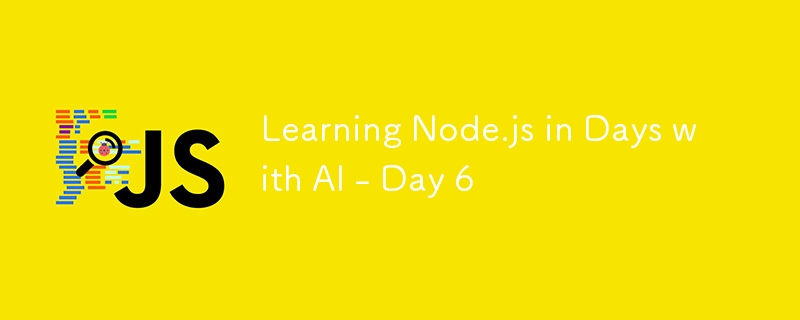
今天是我 Node.js 學習冒險的第六天,我深入研究了 EventEmitter 類別的迷人世界。以下是我如何瀏覽它以及我在這個過程中學到的東西。
EventEmitter 類別是 Node.js 中用來管理事件的基石。它提供了一種強大的方法來創建、發出和處理事件,這對於建立依賴事件驅動架構的應用程式至關重要。
EventEmitter 的關鍵方法:
任務: 建立自訂事件和處理程序。
我先建立一個擴展 EventEmitter 的類別並新增自訂事件處理程序。這是我所做的一步一步的說明:
我創建了一個名為 DataProcessor 的類,它擴展了 EventEmitter。這個類別有一個 processData 方法來模擬資料處理。
const EventEmitter = require('events');
class DataProcessor extends EventEmitter {
processData(data) {
this.emit('start');
// Simulate data processing
setTimeout(() => {
this.emit('data', data);
this.emit('end');
}, 1000);
}
}
然後,我初始化了 DataProcessor 類別並為三個事件定義了處理程序:「start」、「data」和「end」。
// Initialization
const processor = new DataProcessor();
// Event handlers
processor.on('start', () => console.log('Processing started...'));
processor.on('data', (data) => console.log(`Processing data: ${data}`));
processor.on('end', () => console.log('Processing completed.'));
最後,我呼叫了 processData 方法來查看正在執行的事件。
processor.processData('Some data');
看著事件的發生順序是有啟發性的。控制台輸出顯示了從啟動流程到處理資料並完成的流程。
任務:使用事件開發通知系統。
對於獨立任務,我設計了一個Notifier類別。以下是我的處理方法:
const EventEmitter = require('events');
class Notifier extends EventEmitter {
constructor() {
super();
this.notifications = [];
}
addNotification(notification) {
if (typeof notification !== 'string') {
this.emit('error', 'Notification must be a string');
return;
}
this.notifications.push(notification);
this.emit('notify', notification);
if (this.notifications.length > 0) {
this.emit('complete');
}
}
}
我設定了「通知」、「錯誤」和「完成」的處理程序。
const notifier = new Notifier();
notifier.on('notify', (message) => console.log(`New notification: ${message}`));
notifier.on('error', (err) => console.error(`Error: ${err}`));
notifier.on('complete', () => console.log('All notifications processed.'));
我透過新增通知和處理潛在錯誤來測試系統。
notifier.addNotification('This is your first notification.');
notifier.addNotification('This is your second notification.');
notifier.addNotification(123); // This should trigger an error
看到如何處理通知、報告錯誤以及觸發完成事件是令人滿意的。
今天對 EventEmitter 的探索極大加深了我對 Node.js 事件驅動程式設計的理解。實作自訂事件和處理程序是了解事件如何流動以及如何有效管理事件的好方法。這次獨立任務進一步強化了這些概念,並讓我獲得了建構通知系統的實務經驗。
我很高興能繼續這趟旅程,看看接下來的幾天會發生什麼事!
ChatGPT 創建的所有課程都可以在以下位置找到:https://king-tri-ton.github.io/learn-nodejs
以上是利用 AI 快速學習 Node.js - 第 6 天的詳細內容。更多資訊請關注PHP中文網其他相關文章!




